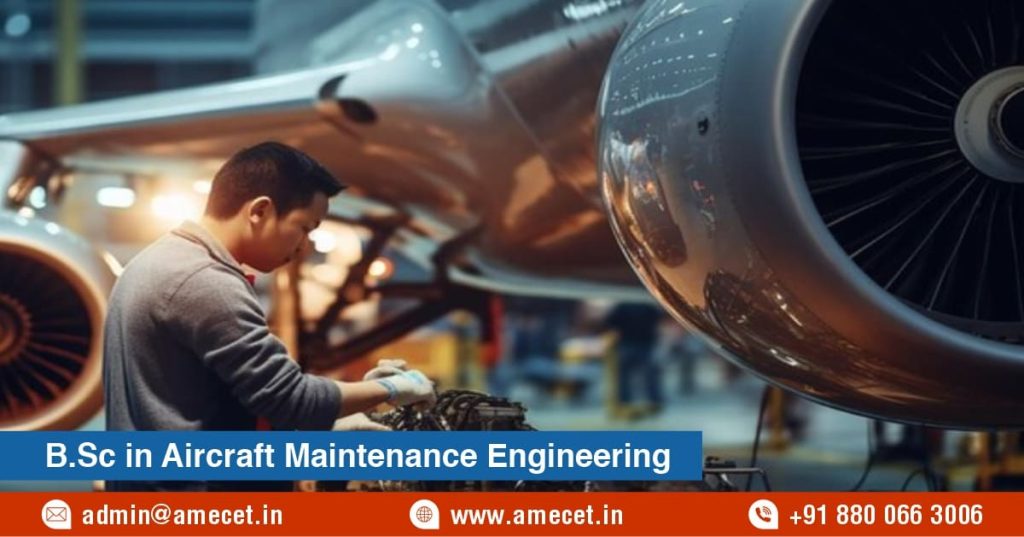How B.Sc. in AME is different from License in AME?
Posted on : 16 January, 2024 1:27 pm
BSc in Aircraft Maintenance engineering
Bachelor of Science (BSc) in Aircraft Maintenance Engineering (AME) is an undergraduate academic degree program that focuses on comprehensive understanding of aircraft systems through theoretical and practical coursework. It provides a broader knowledge base about aircraft systems, maintenance practices, and aeronautical engineering principles.
License in Aircraft Maintenance Engineering
AME license is a professional certification obtained through practical training and examinations. It signifies specific competency in aircraft maintenance, meeting regulatory standards. The license is mandatory for those aiming to work as certified aircraft maintenance engineers, ensuring hands-on skills and adherence to industry regulations.
Important Key differences Between B.Sc. in ame and License in AME
Eligibility criteria for B.Sc. and License in AME courses
- Candidate appearing or passed 10+2 with PCM from a recognized board. or 3 years engineering diploma in any stream from recognized university/board or Approved from AICTE.
- AME course can also be pursued by the one eligible for B.Tech in any stream.
- Candidate age can be between 16 to 28 years at the time of admission.
- Candidate must not have color blindness and any physical disabilities.
- Candidate must have minimum of 45% marks in 10+2 with PCM or equivalent.
Duration and Structure of Course
BSc in AME:
The duration of a BSc in AME typically spans three years, structured as an undergraduate academic program. It encompasses a balanced curriculum of theoretical coursework and hands-on training, covering aviation systems, engineering principles, and regulatory aspects. AME License: The duration of obtaining an AME License varies 2 to 3 year typically consists of both theoretical and practical training. The course is usually 2400 hours in length. The structure is focused on hands-on experience, ensuring proficiency in specific maintenance categories such as airframe, powerplant, or avionics.
Degree vs Certification
BSc in AME: BSc in Aircraft Maintenance Engineering (AME) results in an academic degree approved By UGC (University Grants Commission) of India , signifying completion of a comprehensive program covering theoretical and practical aspects of aircraft maintenance. AME License: AME License is a professional certification issued by aviation authorities. In India AME License is issued by DGCA (Directorate General of Civil Aviation) . It demonstrates practical competence in specific maintenance areas, indicating compliance with industry standards. While the degree provides a broader knowledge base, the license is a targeted certification essential for legally performing hands-on aircraft maintenance tasks.
Course curriculum for B.Sc. in AME and License in AME
BSc in Aircraft Maintenance Engineering (AME) Curriculum:
- Basic Engineering Sciences: Mathematics, Physics, and Chemistry courses providing foundational knowledge.
- Aircraft Systems: In-depth study of aircraft structures, avionics, and propulsion systems.
- Materials and Manufacturing Processes: Understanding materials used in aircraft construction and manufacturing techniques.
- Aerodynamics and Flight Mechanics: Principles of aerodynamics and the mechanics of flight.
- Aircraft Regulations and Standards: Overview of national and international aviation regulations.
- Aviation Safety and Human Factors: Study of safety protocols and human factors affecting aircraft maintenance.
AME License Curriculum:
- Airframe Systems: Detailed study of airframe structures and systems.
- Powerplant Systems: In-depth understanding of aircraft engine systems and components.
- Maintenance Procedures: Practical application of maintenance procedures and troubleshooting techniques.
- Practical Experience: Accumulation of hands-on experience through supervised maintenance tasks.
- Examinations: Rigorous examinations to test practical skills and theoretical knowledge.
- Specialization (Optional): Opportunity for specialization in airframe, powerplant, or avionics categories.
Career Opportunities after courses
For B.Sc. in AME
- Aircraft Technician: Performing scheduled maintenance, repairs, and inspections to keep aircraft in operational condition.
- Technical Services Engineer: Providing technical support to address internal or external technical issues, assisting customers over the phone or computer.
- Graduate Engineering Trainee: Assisting with assigned tasks, supporting projects, conducting research, and maintaining a growth mindset.
- Hardware Design Engineer: Preparing and maintaining documents during the design and development process, specifying equipment requirements and testing notes.
- Production Planning Engineer: Overseeing project progress, troubleshooting production issues, handling paperwork, and monitoring production costs.
For License in AME
- Aircraft Maintenance Engineer (AME): Performing scheduled maintenance, repairs, and inspections on aircraft to ensure airworthiness.
- Quality Control Inspector: Ensuring that maintenance and repair work complies with regulatory standards and safety protocols.
- Technical Support Engineer: Providing technical assistance to resolve issues related to aircraft maintenance or avionics systems.
- Aircraft Modification Specialist: Working on the modification and upgrade of aircraft systems or structures to meet specific requirements.
- Safety Officer: Overseeing safety protocols and ensuring adherence to regulatory guidelines within the maintenance process.
In conclusion, pursuing a BSc in Aircraft Maintenance Engineering (AME) provides a comprehensive academic foundation, while obtaining an AME License signifies practical competence and adherence to industry standards. Both paths offer diverse career opportunities in aircraft maintenance, avionics, engineering, and related fields. The BSc program imparts a broader knowledge base, while the AME License focuses on specialized hands-on skills, ensuring graduates are well-equipped for various roles in the aviation industry.

